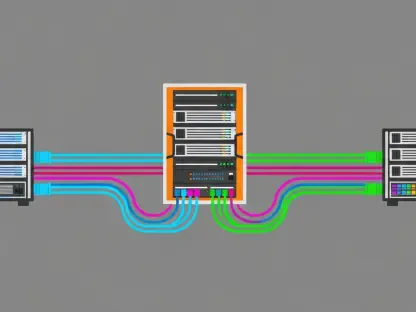In today’s swiftly evolving digital economy, Virtual Data Rooms (VDRs) have increasingly become indispensable tools for organizations seeking secure and efficient data handling solutions. As businesses strive to protect sensitive information amid growing cyber threats, VDRs offer a comprehensive platform that meets these needs with exceptional security capabilities. Their utility extends across industries, driven by digital transformation and the necessity for robust data protection solutions. VDRs facilitate the secure sharing of information during complex business transactions, compliance activities, and more. With the steady rise in data breaches, organizations are turning to VDRs to safeguard their digital assets, making these platforms an essential component in today’s business landscape.
The Dynamics of the U.S. VDR Market
Market Growth and Drivers
The U.S. VDR market has been witnessing rapid expansion, attributed to a heightened necessity for secure data sharing in increasingly complex business environments. This growth is not only driven by digital transformations that prioritize cyber resilience but also by the increasing frequency and sophistication of cyber threats. Organizations across sectors have recognized the critical importance of safeguarding their data, thereby adopting VDR solutions extensively. The need for confidentiality and security, particularly in scenarios involving mergers and acquisitions or regulatory compliance, has propelled the adoption of VDRs. Enterprises are driven toward these platforms as they aim to mitigate risks associated with data breaches, ensuring that sensitive information remains tightly secured.
Technological advancements also play a pivotal role in the market’s growth, with innovations enhancing the capacity of VDR offerings. As organizations become more data-centric, the requirement for agile, secure platforms capable of handling vast amounts of sensitive data becomes more pronounced. Companies operating in diverse sectors such as legal, healthcare, and financial services particularly depend on VDRs to seamlessly manage confidential data while adhering to strict compliance requirements. As these sectors continue to evolve, the integration of advanced analytics and machine learning into VDR platforms provides enterprises with greater insight and operational efficiencies, paving the way for increased market adoption.
Security Features and Technological Innovations
Virtual data room providers continuously innovate to bolster the security features of their offerings, reflecting the overarching importance of data protection. Advanced encryption techniques have become a cornerstone, ensuring that data remains secure throughout its lifecycle. Multi-factor authentication has emerged as a standard practice, facilitating enhanced access controls. This evolution reflects the global emphasis on maintaining the integrity, availability, and confidentiality of sensitive data. Incorporating technologies such as artificial intelligence has significantly improved these security measures, enabling predictive analytics in threat detection and response. As organizations shift towards remote work models, VDRs provide an essential framework for maintaining robust security measures across distributed networks.
The role of machine learning in VDRs has also expanded, enhancing capabilities in data management and cybersecurity. Machine learning algorithms enable platforms to automate routine tasks, analyze large data sets, and detect anomalies with greater efficiency. These technologies equip organizations with powerful tools to anticipate potential security breaches, enable seamless compliance, and track user activity with precision. Moreover, blockchain is redefining security within VDRs, offering immutable records and enhanced transparency in data transactions. Blockchain integration helps ensure that all data exchanges are authenticated and secure, further reinforcing the trust users have in VDR systems. Through these cutting-edge technologies, VDRs not only enhance security but also streamline operational processes.
Key Segments Shaping the Market
Deployment Preferences and Organizational Use
In today’s digital landscape, deployment preferences in the VDR market highlight a pronounced shift towards cloud-based solutions, with these platforms capturing the majority market share. The preference for cloud-based VDRs is largely attributed to their cost-effective models, which offer businesses flexible pricing structures alongside significant scalability. Such advantages make cloud VDRs particularly attractive to financial services, healthcare, and legal sectors where the demand for collaborative efforts and robust compliance frameworks is paramount. Organizations leverage the connectivity and scalability provided by cloud infrastructures to streamline data operations efficiently while maintaining stringent security standards.
As large organizations continue to dominate the market, they frequently engage in transactions requiring complex data exchange, such as mergers and acquisitions and regulatory filings. Consequently, their demand for sophisticated data management protocols is on the rise. Notably, small and medium enterprises (SMEs) are swiftly gaining traction in the market as they increasingly adopt VDR solutions tailored to their unique requirements. These enterprises recognize that embracing affordable, scalable, and secure cloud-based solutions is essential for protecting their sensitive data. This trend highlights the VDR industry’s ability to cater to diverse organizational sizes, providing tailored services to effectively address distinct data security needs.
Business Functions and End-User Analysis
In examining the market through the lens of business functions, the legal and compliance category emerges as a leader in VDR utilization, driven by the imperative need for secure management throughout mergers, acquisitions, and litigation processes. VDRs stand out for their ability to streamline complex due diligence and regulatory compliance tasks, making them invaluable in legal frameworks where information security is paramount. These solutions allow for seamless and protected information exchanges, ensuring adherence to rigorous legal requirements. As legal regulations evolve, the reliance on VDRs continues to grow, supporting organizations in maintaining compliance amid changing legal landscapes.
The financial management sector is experiencing the most rapid growth in adopting VDR solutions, spurred by the increasing demand for digitized financial operations and swift access to sensitive data. Investment banking, initial public offerings, private equity, and fundraising activities are key areas within this sector where VDRs are indispensable. The rigorous requirements for security and accessibility propel financial institutions to seek out advanced VDR solutions that optimize their operations. As the financial landscape shifts toward digital transformation, this sector’s need for VDRs becomes ever more pronounced. Additionally, the healthcare industry is poised for significant growth as electronic health records gain prominence, driving demand for secure data management solutions in clinical trials and affiliations.
Fragmentation and Competitive Landscape
Providers and Custom Solutions
The VDR market is notably fragmented, comprising a diverse spectrum of providers who offer specialized solutions tailored to meet specific industry needs. Established enterprises like Intralinks and Citrix Systems stand out as dominant forces, having cultivated broad-ranging solutions that cater to diverse clients and complex data management scenarios. These established providers emphasize scalability and security, positioning themselves as key players while continuously evolving their offerings to remain competitive. On the opposite end of the spectrum are emerging players dedicated to addressing niche industries’ specialized needs. They differentiate themselves through agile, innovative solutions, enabling flexibility and customization that align with unique sector requirements.
This fragmentation results in a dynamic, competitive landscape where customization and specialization are paramount. The abundance of providers grants businesses the autonomy to select VDR solutions that best align with their operational and security objectives. As a result, organizations benefit from customized solutions that enhance efficiencies and security protocols, reflecting the market’s inherent flexibility. Companies are therefore empowered to adopt VDRs that meet their specific requirements, fostering an environment where innovation thrives and varied solutions cater effectively to a broad array of industry needs. This competitive dynamic underscores the strategic importance of continuous innovation by VDR providers as they strive to differentiate themselves in a rapidly evolving market.
Recent Developments and Strategic Growth
The U.S. Virtual Data Room (VDR) market is experiencing swift growth due to the increasing need for secure data sharing in complex business environments. This upsurge stems not only from digital transformations emphasizing cyber resilience but also from the rising occurrence and complexity of cyber threats. Various industries now regard protecting their data as essential, leading to widespread adoption of VDR solutions. The demand for confidentiality and security, particularly during mergers and acquisitions or for regulatory compliance, is driving the use of VDRs. Businesses seek these platforms to protect against data breaches, ensuring sensitive information is safeguarded.
Technological advancements significantly contribute to market expansion, with innovations enhancing VDR capabilities. As firms become more data-driven, the necessity for adaptable, secure platforms handling large volumes of sensitive data intensifies. Industries such as legal, healthcare, and finance rely on VDRs to efficiently manage confidential information while adhering to strict regulations. As these sectors evolve, integrating advanced analytics and machine learning into VDR systems offers deeper insights and efficiency, promoting greater market adoption.









